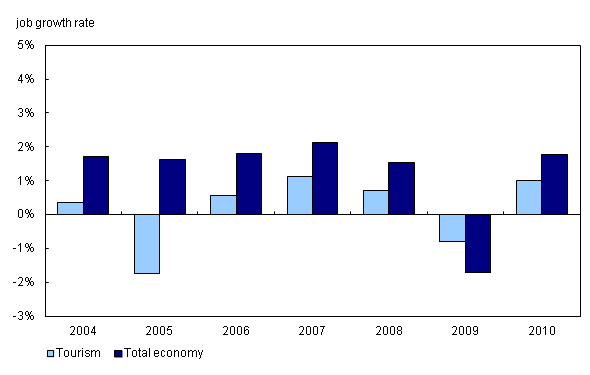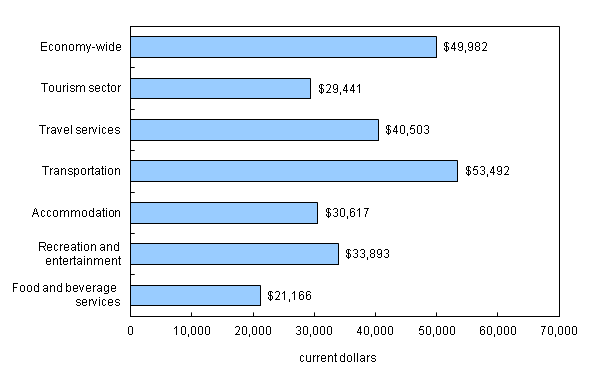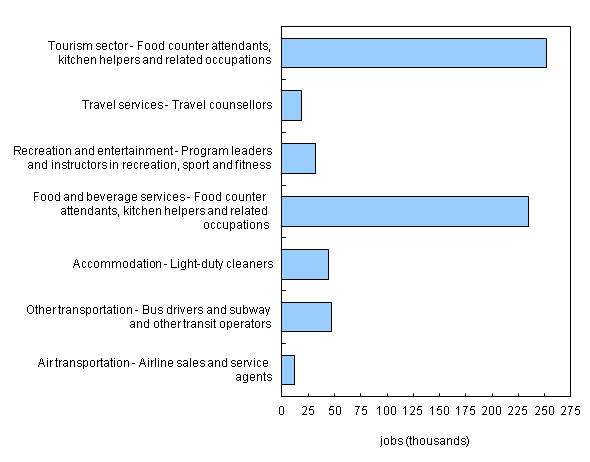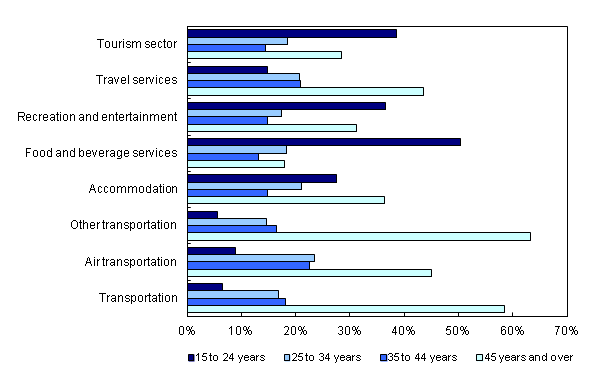Publications
Income and Expenditure Accounts Technical Series
Human Resource Module of the Tourism Satellite Account, 2010
Results
Archived Content
Information identified as archived is provided for reference, research or recordkeeping purposes. It is not subject to the Government of Canada Web Standards and has not been altered or updated since it was archived. Please "contact us" to request a format other than those available.
Tourism sector
Tourism industries profiles
Occupations in tourism industries
Profile of employees in tourism industries
The intent of this section is to highlight some of the findings and to illustrate some of the types of analyses the Human Resource Module (HRM) can support. The analysis will focus on the year 2010 and on comparisons with preceding years. A brief description of the general economic conditions prevailing in Canada and in the tourism sector in 2010 is provided first. This description is used as background for the subsequent analyses in sections 5.1 to 5.4.
Real gross domestic product (GDP) advanced 3.3% in 2010 in Canada as the economy continued its upturn (see Table 1). Personal expenditure on consumer goods and services increased 3.4%, driven by spending on services. Final domestic demand1 rose by 4.4% compared to the previous year, while exports of goods and services climbed 6.4%, boosted by exports of goods (+7.3%).2
Tourism spending in Canada in tourism industries increased 4% in real terms in 2010 (compared to a drop of 3.1% in 2009), as tourism spending by Canadians at home rose by 4.3% and spending by international visitors grew 2.9%.
Tourism sector
This section aims to compare key variables of the HRM: jobs, hours worked and compensation for the tourism sector in Canada with the overall economy in Canada over time.
Compensation for all jobs
Compensation3 reached $48.8 billion in 2010 for tourism industries in Canada, up 4.6% from the previous year, outpacing the 3.9% growth of compensation for the total economy (see Table 2). This growth was mainly due to an increase in hourly compensation (+4.8%) and to a lesser extent to an increase in the number of jobs (+1.0%). The number of hours worked per week declined 1.1%.
For the past five years, compensation in tourism accounted for 5.6% of compensation for all jobs in Canada. The highest share was observed in 1999 when tourism accounted for 6.2% of the total.
Jobs
The number of jobs for the total economy grew at a faster pace when comparing to jobs in the tourism industries for the 2004 to 2010 period, except for 2009. On average, employment for the total economy outpaced that of tourism industries by approximately 0.9 percentage points per year (1.0% versus 0.1%). However, in 2009, the number of jobs in tourism industries fell by 0.8%, while jobs overall were down 1.7%.
Tourism industries in Canada generated a total of 1.6 million jobs in 2010. Jobs include both full-time and part-time jobs, as well as employee jobs and jobs from self-employment. The tourism sector accounted for 9.2% of all jobs in Canada in 2010.
Tourism jobs grew 1.0% compared to the total economy (+1.8%) in 2010. These positive results followed a decline of 0.8% in the number of tourism jobs in 2009.
Out of the sixteen thousand jobs created in 2010, more part-time jobs (+15,000) were generated than full-time jobs (+1,000).
Chart 1 Annual rate of job growth in tourism industries and total economy, Canada
Description for Chart 1

It should be noted that the measure of jobs in the HRM includes all jobs in tourism industries. This exceeds the measure in the Canadian Tourism Satellite Account (CTSA) and the National Tourism Indicators (NTI) of jobs attributed to visitor's consumption (spending or demand), because only a portion of the 1.6 million jobs can be attributed to visitors. Jobs generated by tourism spending in tourism industries totalled 497,000 in 2010.4
In 2010, jobs in tourism generated by visitor's consumption (tourism demand) declined slightly by 0.1%. However, jobs in tourism industries generated from both visitor and local resident's consumption were not affected as much (+1.0%) because of sustained local consumption.
The tourism industries provided 649,000 part-time jobs (40.4% of all jobs in the sector) in 2010. Part-time jobs made up 23.1% of all jobs in Canada. The share of part-time employment in the tourism sector and economy-wide has risen in the last three years.
Self-employment was less common in tourism, accounting for 7.1% of jobs in 2010, compared to 9.3% economy-wide. Nevertheless, the number of self-employed in tourism grew by 1.7% when compared to the previous year.
Hours worked per job
The average work week in the tourism sector is shorter than in the rest of the economy, about 10% shorter from 1997 to 2010. Jobs in tourism averaged 28.8 hours per week in 2010, down 1.1% from the previous year, compared to 32.7 hours for all jobs (see Table 4).
The shorter week in tourism reflects the higher proportion of part-time jobs found in tourism industries than economy-wide and the lower proportion of self-employed in tourism. Jobs from self-employment in tourism involved longer working hours (34.5 hours per week), compared to jobs from self-employment economy-wide (32.3 hours per week).
Compensation per job
Hourly compensation in tourism averaged $20.26 per hour in 2010, up 4.8% from the previous year (see Table 2), but still much lower than the hourly compensation economy-wide of $30.02.5 In 2010, hourly compensation for full-time workers was $21.53, while part-time workers received $15.73. However, for the past five years, hourly compensation for part-time workers increased at a faster pace than that of full-time workers.
Tourism industries profiles
The HRM contains aggregated data for five tourism industry groups: transportation (with details for air transportation and other transportation reported separately), accommodation, food and beverage services, recreation and entertainment and travel services. Appendix E lists the industries included in each industry group of the tourism sector. The following provides selected results intended to give an indication of the kinds of industry analyses possible with the HRM.
Food and beverage services
Among the tourism industry groups, the food and beverage services industry group was the largest employer in 2010. This industry group accounted for 53.1% of all jobs in tourism industries in Canada with 851,600 jobs (see Table 3). In 2010, the number of jobs increased 1.1% driven by an increase in the number of part-time jobs. Almost 19,000 part-time jobs were created, while more than 9,600 full-time jobs vanished.
Food and beverage services held the highest share of part-time jobs (49.4%) among tourism industries in Canada. Not surprisingly, the work week in this industry, at 26.7 hours, was the shortest among all tourism industries and was below the average work week of 32.7 hours economy-wide (see Table 4).
In 2010, the self-employed held 26,309 jobs in food and beverage services, accounting for 23.1% of all self-employed jobs in the tourism sector. They worked the longest hours, 41.9 hours per week, well above the self-employed average of 34.5 hours per week in the tourism sector.
Jobs in food and beverage services continued to pay the least of all tourism industries, with an average hourly compensation of $15.896 in 2010 (see Table 2). Even though this was up (+5.7%) from the previous year, it remained well below the average of $20.26 for tourism industries in Canada.7
It should be noted that the average hourly wage for all employee jobs in food and beverage services was $14.61 in 2010 (see Table 5). This is $1.28 less than the average hourly compensation ($15.89), which includes supplementary labour income (employer contributions on behalf of employees to employment insurance, private and public pension plans, worker's compensation, health and life insurance plans and retirement allowances).
Annual compensation combines information about hourly compensation and hours worked. In food and beverage services industries, jobs paid $21,166 on average in 2010 (see Chart 2). This was well below the tourism sector average of $29,441. Jobs in food and beverage services involved the fewest working hours per week and were paid the least on an hourly basis in the tourism sector.
Chart 2 Annual compensation in tourism industries in Canada, 2010
Description for Chart 2

Recreation and entertainment
The recreation and entertainment industry group was the second largest employer among the tourism industries, providing 267,000 jobs or 16.6% of employment in the sector. This industry group registered a very small decrease in jobs in 2010. However, the industry has gained in terms of its share of sector employment over the years. In 1997, it accounted for 15.5% of all jobs in the sector.
The large proportion (40.5%) of part-time jobs in recreation and entertainment contributed to a short work week. Moreover, jobs in this industry recorded the largest decline (-3.3%) in the work week when compared to the previous year. Averaging 28.3 hours, it was among the shortest in tourism industries.
Recreation and entertainment held the largest proportion (43.3%) of self-employed, with 49,400 jobs. However, they worked shorter hours (26.8 hours per week) than the self-employed in the tourism sector overall (34.5 hours per week).
Hourly compensation in this industry ($24.22) was above the tourism sector average ($20.26), but remained below hourly compensation economy-wide ($30.02). Annual compensation reached $33,893 in 2010, above the tourism sector average, even though the work week was among the shortest in the sector.
Accommodation
The accommodation industry generated 234,000 jobs in 2010, or 14.6% of jobs in the tourism sector, making it the third largest employer among tourism industries in Canada. The accommodation industry group registered its fourth consecutive annual increase in employment, in 2010.
All of the increase was in full-time positions, as the industry gained seven thousand full-time jobs, but lost about one thousand part-time jobs. Hours worked per week in accommodation fell to 31.1 hours in 2010, from 31.5 hours in 2009, but remained above the tourism sector average of 28.8 hours per week.
The proportion of part-time jobs (27.0%) in this industry group, while higher than economy-wide (23.1%), remained below the sector average of 40.4%. The proportion of self-employed (4.2%) was among the lowest in the tourism sector, with 9,900 self-employed in 2010.
Hourly compensation in accommodation, which includes gratuities, was up 5.3% in 2010 to reach $19.55, but was still below the tourism sector average of $20.26. Annual compensation in this industry group, at $30,617, was higher than the sector average, mainly because of a longer work week (31.1 hours) compared to the sector (28.8 hours).
Transportation
The transportation industry group consists of air transportation and other transportation, including rail, water and bus transportation, as well as taxis and car rentals. This industry group generated 210,700 jobs, or 13.1% of all jobs in tourism in Canada. Jobs in transportation industries were up 0.6% in 2010. The gain was centered mainly in air transportation (+1,035 jobs) while other transportation saw its workforce reduced slightly. More part-time jobs were created than full-time jobs in 2010.
Jobs in transportation came with a long work week, on average 34.1 hours, five hours more than the average for tourism jobs in Canada. One reason for the longer hours is the higher proportion of full-time jobs (76.8%), particularly in other transportation industries. Another reason is the relatively high proportion (11.8%) of self-employed in transportation industries, who work longer hours (43.0 hours per week). For the tourism sector as a whole, the self-employed make up only 7.1% of jobs. Transportation supported 24,900 thousand jobs from self-employment, of which, almost all of them were in the other transportation industries.
In addition to the second longest work week, jobs in transportation were paid more than in other tourism industries, with an hourly compensation of $30.06, $9.80 per hour more than the average across all tourism jobs in Canada ($20.26). Hourly compensation was particularly high in air transportation, at $37.07 per hour.
Transportation is the only industry group in the tourism sector with an annual compensation ($53,492) above the Canada-wide average of $49,982. The long work week and the high hourly compensation in both air and other transportation contributed.
Travel services
The travel services industry group is the smallest among all tourism industries. Travel services generated 43,100 jobs in 2010, down 0.7% from the previous year. This industry group accounted for only 2.7% of all jobs in tourism in Canada.
Jobs in this industry group were mostly full-time (81.5%), the highest proportion among all tourism industries. Not surprisingly, this industry group had the longest work week, 35.0 hours. Three thousand five hundred workers were self-employed, 8.2% of all jobs in travel services, slightly above the 7.1% share of self-employed for the tourism sector overall.
Annual compensation was among the highest in the tourism sector, at $40,503, owing to the high proportion of full-time jobs and above average hourly compensation.
Occupations in tourism industries
Five occupation groups dominated the food and beverage services industry in terms of employee jobs: food-counter attendants, kitchen helpers and related occupations with 235,000 jobs; food and beverage servers with 174,000 jobs; cooks with 126,000 jobs; restaurant and food service managers with 71,000 jobs; and cashiers with 53,000 jobs. Furthermore, these were the top five occupations in the tourism sector.
The most prevalent occupation in the accommodation industries group was light duty cleaner, with 44,000 employee jobs (see Chart 3). Bus drivers and subway and other transit operators was the main occupation group in other transportation industries, with 47,000 jobs, while program leaders and instructors in recreation, sport and fitness were the most common occupation in recreation and entertainment, with 32,000 jobs. Travel counsellors accounted for only 19,000 jobs, but represented the primary occupation in travel services (see Chart 3). The main occupation in air transportation was airline sales and service agents.
When comparing wages for the same jobs, bus drivers and subway and other transit operators ($23.72), airline sales and service agents ($22.80), program leaders and instructors in recreation, sport and fitness ($18.91), earned more than the tourism sector average of $18.31. On the other hand, travel counsellors ($18.23), light duty cleaners ($14.21) and food counter attendants, kitchen helpers and related occupations ($12.62) earned less than the tourism sector average.
Chart 3 Main occupation in each tourism industry group in Canada, 2010
Description for Chart 3

Profile of employees in tourism industries
The HRM provides details concerning three characteristics of employees: gender, age group, and immigrant status. The following highlights some of the HRM results according to these demographics (see Table 5).
Gender
Women working in the tourism sector accounted for 55.2% of employee jobs in 2010. This share has declined slightly since 2006.
Women held 823 thousand employee jobs in the tourism sector in 2010, 154 thousand more than men. A higher proportion of women working in tourism industries were less than 25 years of age (41.2%) compared to men (35.4%).
Women were under-represented in only one industry group, transportation. Only 30.1% of the employee jobs in this industry were held by women. On the other hand, women held the majority of jobs in travel services (75.0%).
In all tourism industries, women had shorter work weeks than their male counterparts. This was especially the case for air transportation (27.3 hours per week for women compared to 36.2 hours for men) and other transportation industries. Women (45.6%) were also more likely than men (34.7%) to work in part-time jobs.
Women working in tourism industries in Canada earned on average $4.62 less than men ($16.03 per hour versus $20.65). There was a noteworthy variation in women's wages, with jobs in air transportation paying the most, $26.39, and jobs in food and beverage services paying the least ($13.76). Even though women in air transportation jobs were well paid, they were still paid $7.45 less than men on average.
The majority of women employed in the tourism sector worked in food and beverage services industries (60.3%), where wages paid to women were the lowest, $13.76 per hour, and the number of hours worked were the lowest, 24.4 hours per week. Only 49.2% of men employed in the sector were in this industry.
The most common occupation for women was food and counter attendants and kitchen helpers and related occupations, while the most common for men was bus drivers and subway and other transit operators, where hourly wages were higher and hours worked per week longer.
In 2010, women earned an annual salary of $21,619 in the tourism sector compared to $33,628 for men.
Chart 4 Job share by age group in tourism industries in Canada, 2010
Description for Chart 4

Youth and older workers
Youth aged 15 to 24 years were a major source of labour for the tourism industries in Canada in 2010. They held 576,000 employee jobs, accounting for four out of ten employee jobs in tourism. Three out of four young workers were employed in the food and beverage services industries. The most common occupation among youth was food counter attendants, kitchen helpers and related occupations.
Older workers, aged 45 years or older, were also an important source of labour for tourism, holding 424,000 employee jobs (28.4%). In 2010, older workers were employed more evenly across all tourism industries compared to young adults. Two tourism industry groups employed a notably older workforce: older workers accounted for 63.3% of all employees in other transportation industries and 45.0% of all employees in air transportation (see Chart 4).
Almost seven out of ten young workers were working in part-time jobs in tourism compared to about one out of four older workers. The vast majority of young adults that worked part-time were employed in the food and beverage services industry. Young adults worked fewer hours per week (17.2 hours) compared to older workers (35.4 hours). This was especially the case in the recreation and entertainment industries (15.0 hours for young adults versus 34.7 hours for older workers). According to the Labour Force Survey, in 2010 about 90% of young workers gave attending school as main reason to be working part-time.
Wages of young workers were also considerably lower. The hourly wage among workers in tourism industries aged 15 to 24 was $12.25 in 2010, almost half that of employees aged 45 and over ($22.40). The wage differential between young and old workers was the most pronounced in the air transportation industry group, $15.89 versus $38.35, respectively.
Immigrants
Immigrants are an important source of labour for the tourism sector in Canada. In 2010, immigrants held 339 thousand jobs, accounting for 22.7% of employee jobs in tourism. Almost 59.0% of all immigrants employed in the sector worked in the food and beverage services industry compared to 54.2% of non-immigrants. On the other hand, only 8.8% of all immigrants employed in the sector worked in recreation and entertainment compared to 16.3% of non-immigrants. The concentrations were similar between immigrants and non-immigrants in other tourism industry groups.
Immigrants in tourism industries were older than other tourism workers. About four out of ten immigrants were 45 years or older, while one out of four non-immigrants was an older worker.
Compared to non-immigrants (56.6%), immigrants (68.4%) were more likely to work full-time. In 2010, immigrants worked longer hours than their non-immigrant counterparts, 33.0 hours per week versus 27.0 hours.
Among the main occupations across all tourism industries, immigrants made up 35.9% of light duty cleaners, 33.4% of airline sales and service agents, 32.7% of travel counsellors, 23.4% of food counter attendants and kitchen helpers, 21.3% of bus drivers and subway and other transit operators and, 9.9% of program leaders and instructors in recreation, sport and fitness.
Immigrants earned lower wages per hour ($17.34 per hour) than non-immigrants ($18.67 per hour). In transportation industries, wages were notably lower ($23.43 for immigrants versus $29.34 for non-immigrants). However, when looking at the annual salary, immigrants were paid more in all tourism industries (with the exception of transportation and travel services) with an average salary of $29,708 versus $26,247 for non-immigrants. Even though immigrants earned lower wages per hour on average, they compensated by working longer hours.
Data tables
- Table 1 Gross domestic product, tourism gross domestic product, tourism expenditures and jobs in tourism industries and total economy, Canada
- Table 2 Annual compensation and hourly compensation in tourism industries and total economy, Canada
- Table 3 Jobs in tourism industries and total economy, Canada
- Table 4 Weekly hours worked in tourism industries and total economy, Canada
- Table 5 Employee jobs, hours and wages by employee characteristics in tourism industries, Canada, 2010
Notes
- Final domestic demand consists of consumer spending, government expenditures and business investment.
- Source: Statistics Canada, National Income and Expenditure Accounts: Data Tables, catalogue no.13-019-X.
- Compensation is defined as wages and salaries, supplementary labour income and the labour portion of income after expenses accruing to the self-employed.
- See Statistics Canada 2011b.
- It should be noted that assumptions used to estimate labour compensation in tourism are not exactly the same as the ones used for the total economy, as explained in Appendix D.
- This statistic is based on compensation in employee jobs and jobs from self-employment.
- Gratuities are included in these figures. See Appendix C to understand how gratuities are calculated.
- Date modified:
